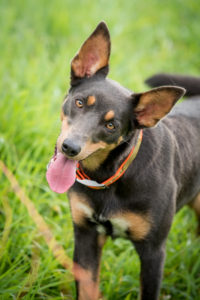
Bringing your pets with you, whether to live here permanently or on an extended visit, is not simple, but it can be done. I waited about 11 months, spent more money than I ever want to total, and went through quite a bit of work to bring in Kate, who was born in Oklahoma.
I don’t regret a moment of the hassle it required, or the money, but if I hadn’t been set on getting another kelpie, it would have been a foolish thing to do.
Puppies are more challenging to import than adult dogs with a history of rabies vaccinations.
Bringing in an adult pet, up to date on rabies vaccinations, is not too bad. But a puppy has to be 4 months old before it can receive its first shot, and then the shots must be spaced at least a month apart, and the blood for the titer should not be drawn until so many days after the last shot, and on and on it went. (Kate was about 5 weeks old when I bought her.).
I have clients who are flying in with their dog and cat from California in a week. I haven’t discussed the process with them yet, but I gather it has been one of the least challenging aspects of their move, because their pets are adults, and have received rabies shots annually. With a record of rabies shots, few vet visits would be required-perhaps only one to draw blood for the rabies titer, and a second for a certificate of health right before the flight. They also have a shorter trip, which should help. They, like Kate, will fly directly to Kona, where a vet will meet their pets and complete the paperwork necessary for their release to my clients.
Many owners in the Mauna Lani and Mauna Kea Resorts bring their small dogs with them when they come to stay.
Quite a few people who own second homes at the Mauna Lani and Mauna Kea resorts bring their small dogs with them every time they come. Not all condominium projects allow pets, but many do, especially single, small-ish dogs. Once you’ve got the system established, it can be pretty easy to bring along your small dog.
Do it yourself, or hire help?
Because I was relying on Kate’s very kind breeder to do the leg work in Oklahoma, I hired a local pet importation coordinator to make sure all the paperwork was completed properly and on time. I don’t think I would do that again, unless I was very, very busy.
There is no doubt in my mind that going through the process of getting your pets certified as rabies-free is far better than consigning them to quarantine once they arrive here, but it does require checking off a number of boxes. Here is a link to the Hawaii Department of Health, Quarantine Branch, setting out the requirements: http://www.hawaiiag.org/hdoa/ai_aqs_info.htm. It sounds like it has become easier for animal owners to comply with the requirements since I brought in Kate, which is a good thing! http://hdoa.hawaii.gov/ai/aqs/aqs-info/
If you want to wait until you arrive to adopt a pet, there will be many lovely animals in need of a new home.
If you don’t have a pet yet, and are considering a move to Hawaii, there are lots of dogs and cats in need of good homes here. There are humane society shelters in several locations on the Big Island, and I have adopted some wonderful pets (including a very silly lamb) from the Waimea Shelter. The breeding of the dogs may sometimes be a bit questionable, but hybrid vigor is on display, and it’s fun to try to guess the breeds of one of our local dog’s ancestors. If you get really curious, you can submit a swab for DNA analysis.
I brought in Kate specifically to work sheep, but I have two dogs that I took in just because they needed new homes that actually do a much better job with the sheep than Kate is ever likely to. Breed matters, but frequently mutts can be a delightful surprise!
